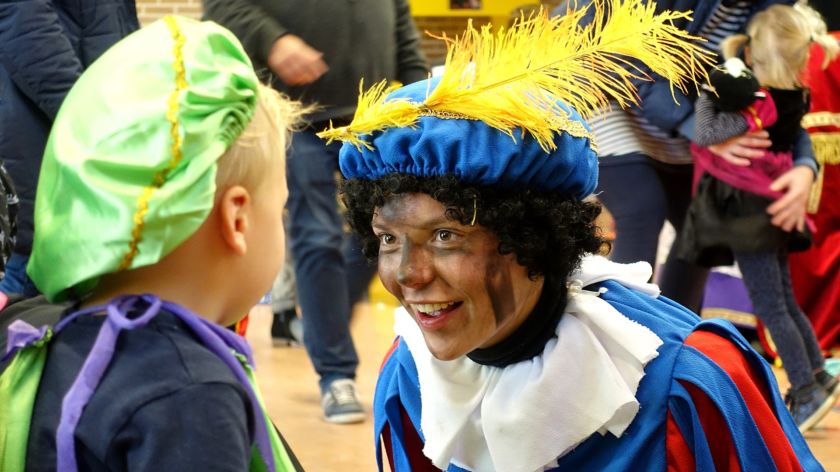‘The underlying problem of structural racism will not be solved by a Sooty-faced Piet’
-
 Roetveegpiet (Sooty-faced Piet) Photo: Ziko van Dijk / Wikimedia Commons.
Roetveegpiet (Sooty-faced Piet) Photo: Ziko van Dijk / Wikimedia Commons.
In the run-up to the Sinterklaas celebration, Coen van Galen has been giving a lecture for some years now which looks at the history of Zwarte Piet and the corresponding discussion. According to historian Van Galen, the discussion has largely been settled in favour of Roetveegpiet. ‘But that doesn't solve the underlying problem: structural racism.’
For some years now, Coen van Galen’s Sinterklaas lecture has been a part of a series of lectures on Dutch history for first-year students. ‘We noticed that the discussion about Zwarte Piet was very much alive, among students too’, says the historian, who is well-known for his research into slavery, on the phone.
Van Galen describes Sinterklaas’ controversial servant as a nineteenth-century construction. ‘Before that time, Sinterklaas was actually a kind of matchmaker: you gave your lover gingerbread dolls and if they accepted, you were a couple. That conflicted with middle class ideals in the nineteenth century. People wanted Sinterklaas to be a civilised character. A gentleman of class and such a person should have a servant.’
Chimney sweep
In the lecture, the historian points out to the students that for a long time, there wasn’t one single Zwarte Piet character in the Netherlands, but rather a whole series of regional traditions. For example, up until the 1920’s to 1930’s in some parts of the Netherlands, Zwarte Piet was a chimney sweep but the diversity disappeared with the arrival of mass media. ‘The national newspapers adopted the Amsterdam version of Zwarte Piet with frizzy hair, red lips and earrings. When the traditional entry into the country of Sinterklaas was first broadcast on television in 1952, that became the Zwarte Piet everyone knows. Since then, Sinterklaas has mostly been depicted with at least two or three servants.’

‘The Sinterklaas celebration is used to project societal concerns’
For the students, Van Galen not only focuses on the character of Zwarte Piet, but also on the way in which we regard the Sinterklaas celebration. ‘The Sinterklaas celebration was and is used as a means of projecting concerns in society’, he says. ‘In the 1970s, there were discussions about the punishments associated with Sinterklaas. People felt that the cane and the sack into which naughty children were put were no longer acceptable. In the 1980s, people were worried that Sinterklaas would disappear and be replaced by Christmas celebrations and Santa Claus.’
Second-class citizens
So why did the discussion about Zwarte Piet only become so heated in the last ten years? ‘The idea that people of colour are not treated as well as the rest of society was pushed aside in the Netherlands for a long time, says Van Galen. ‘As long ago as 1984, Philomena Essed wrote the book Alledaags Racisme (Everyday Racism). In it, she revealed how Surinamese people were often depicted as second-class citizens in jokes. But her book was completely shot down in flames, in the academic community too.’
However, the problems indicated by Essed in her book continued to smoulder in Dutch society. ‘From 2011 onwards, groups such as ‘Kick Out Zwarte Piet’ projected these problems on to the caricature-like elements of Zwarte Piet, like the thick lips’, says Van Galen. ‘Most white Dutch people don’t want to acknowledge that because they have happy memories of the Sinterklaas celebration. For some people, the fear of what they might be losing is so strong that they are willing to fight for it tooth and nail. And so the debate about Zwarte Piet has become a societal battleground on which social problems are imposed.’
Danger
In recent years, the discussion between supporters and opponents of Zwarte Piet has become extremely polarised, but according to Van Galen, there are also similarities between the two groups. ‘Members of the ‘Kick Out Zwart Piet’ group are all highly educated people who speak Dutch well and have good career opportunities but they feel that despite having integrated into Dutch society, they still don’t belong. The supporters of Zwarte Piet see society as a homogeneous white group that they are in danger of losing and they want recognition for their celebration. Their opinions clash, but both groups want the same thing: to be accepted as a part of Dutch society.’
‘Both groups want the same thing: to be accepted as a part of Dutch society’
Now that the Dutch broadcasting foundation, NOS, has also capitulated and since 2019 shows only the sooty-faced Piet, the discussion is almost completely settled, in Van Galen’s opinion. ‘In 2016, two thirds of people felt that Zwarte Piet should stay traditional, but in 2018, that figure was only half. Not only that, but the resistance to change, as was seen in demonstrations recently in Maastricht and Eindhoven, has ended up coming from certain quarters. Few people want to be associated with football hooligans or far right ideals and will accept the sooty-faced Piet in time.’
Left-wing indoctrination
However, Van Galen is concerned that the sooty-faced Piet could well in time prove to be a Pyrrhic victory (a victory with such a devastating cost that it is tantamount to a defeat – ed.) ‘This discussion is almost over, but I’m curious to see what effect it will have on the black community. There is a danger that society in a broader sense is thinking: we’ve dealt with the Zwarte Piet issue so you can stop complaining now. But the underlying problem, that of structural racism, has not been dealt with.’
Incidentally, Zwarte Piet is a charged issue not only in society but also in the lecture hall. ‘There are usually some students who feel that Zwarte Piet should stay as it was’, says Coen van Galen. ‘I don’t have a problem with that. But I do prefer that they discuss it with me rather than going on right-wing fora and complaining about the left-wing indoctrination they’re having to deal with at university. That actually happened: a colleague told me about it last year.’



